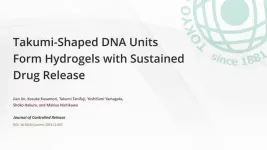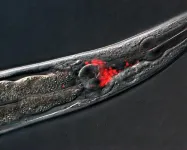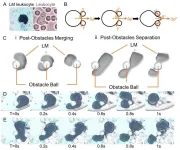Hydrogels are polymeric materials with three-dimensional network structures containing large amounts of water. They serve as sustained-release drug delivery systems as they can encapsulate various bioactive substances, including drugs, antigens, and even cells. Hydrogels are better drug delivery alternatives than conventional systems, as they are more biocompatible, biodegradable, and easily administered as an injectable scaffold.
DNA has gained significant attention as a promising hydrogel material thanks to its customizable physicochemical properties, leading to the development of various DNA hydrogels. However, current methods like DNA ligase-linked hydrogels present many challenges, including potential allergic reactions and complex administration procedures that limit clinical applications.
Recently, a polypod-like nanostructured nucleic acid, or polypodna, was constructed using three or more predesigned oligodeoxynucleotides (ODNs) with partially complementary sequences to address these challenges. These efficient DNA nanostructures are easily injectable and readily reform into hydrogels at the injection site after being injected. While this approach creates self-gelatinizing nucleic acids that form hydrogels without DNA ligase, it requires multiple ODNs, leading to high preparation costs, design complexity, and an increased probability of off-target effects owing to the large number of DNA bases involved.
To address this, a Takumi-shaped DNA unit was formed with only two ODNs. However, studies investigating its optimization as a sustained-release drug carrier or its retention ability are limited.
In their new study, made available online on December 2, 2024, and to be published on January 10, 2025, in Volume 377 of the Journal of Controlled Release, Professor Makiya Nishikawa, along with Mr. Jian Jin, Assistant Professor Shoko Itakura, and Associate Professor Kosuke Kusamori, from the Tokyo University of Science, Japan, aimed to address these aspects of Takumi-shaped DNA nanostructures.
Prof. Nishikawa explained the motivation behind the study, “Our goal was to miniaturize and optimize DNA nanostructures so that stable DNA hydrogels could be formed with fewer nucleic acids.”
Each ODN in the Takumi-shaped DNA structure was constructed with an eight-18 nucleotide-long palindromic stem attached to two cohesive parts on either side with a thymidine (T) spacer. The ODNs form a self-dimer via the palindromic sequence, and each ODN was named according to the number of nucleotides in the stem and cohesive parts. For instance, 14s-(T-10c)2 refers to an ODN with a stem length of 14 nucleotides and a cohesive part of 10 nucleotides located at both ends of the stem.
To optimize the Takumi-shaped DNA as an injectable hydrogel unit with sustained retention, researchers systematically designed various ODN lengths and investigated the correlation between structural properties and hydrogel performance, with a special focus on in vivo retention capabilities.
Their findings showed that the hydrogel properties, such as melting temperatures and stability, depend on the length of the stem and the cohesive parts. ODNs with stem lengths of 12 nucleotides or longer efficiently formed the hydrogel units, suggesting that a 12-nucleotide-long stem is enough for unit formation. Similarly, cohesive parts demonstrated effective hybridization and interactions at a length of 10 nucleotides.
The researchers also assessed the storage modulus of hydrogels, which helps understand how the hydrogel changes under different physical conditions, by varying lengths of cohesive parts, demonstrating that 10-nucleotide-long GC-rich cohesive parts exhibit better thermal stability and storage modulus compared to other formations.
“The length of the 12s-(T-10c)2-ODN, which showed the highest retention in mice, was 34 bases, requiring only two ODNs to form. In total, just 68 nucleotides were needed for DNA hydrogel formation—markedly lesser than the hexapodna-based DNA hydrogel composed of twelve different 40-base long ODNs,” explains Prof. Nishikawa about how their study has achieved efficient hydrogel formation with minimal DNA units.
In vivo experiments with doxorubicin-intercalated DNA hydrogels of 12s-(T-10c)2-ODNs showed prolonged persistence of at least 168 hours post-administration, contributing to pronounced anti-tumor effects in mice, due to the sustained release of doxorubicin at the site of injection. Additionally, Takumi-shaped DNA hydrogels could potentially induce targeted immune responses, making them effective antigen-delivery systems. “The optimized DNA hydrogel prepared using 12s-(T-10c)2 exhibited a more sustained retention than the hexapodna-based DNA hydrogel after in vivo administration in mice. These results highlight the applicability of DNA hydrogels as delivery systems for bioactive materials,” concludes Prof. Nishikawa.
Overall, this study demonstrates how minimal DNA units can assemble to form biocompatible hydrogels with high retention times and sustained drug release capabilities, offering a promising biomedical innovation for targeted therapies.
***
Reference
Title of original paper: Biocompatible DNA hydrogel composed of minimized Takumi-shaped DNA nanostructure exhibits sustained retention after in vivo administration
Journal: Journal of Controlled Release
DOI: 10.1016/j.jconrel.2024.11.052
About The Tokyo University of Science
Tokyo University of Science (TUS) is a well-known and respected university, and the largest science-specialized private research university in Japan, with four campuses in central Tokyo and its suburbs and in Hokkaido. Established in 1881, the university has continually contributed to Japan's development in science through inculcating the love for science in researchers, technicians, and educators.
With a mission of “Creating science and technology for the harmonious development of nature, human beings, and society," TUS has undertaken a wide range of research from basic to applied science. TUS has embraced a multidisciplinary approach to research and undertaken intensive study in some of today's most vital fields. TUS is a meritocracy where the best in science is recognized and nurtured. It is the only private university in Japan that has produced a Nobel Prize winner and the only private university in Asia to produce Nobel Prize winners within the natural sciences field.
Website: https://www.tus.ac.jp/en/mediarelations/
About Professor Makiya Nishikawa from Tokyo University of Science
Dr. Makiya Nishikawa, a Professor at the Faculty of Pharmaceutical Sciences, Tokyo University of Science, received his Ph.D. from Kyoto University. His main areas of research include biopharmaceuticals, with a special focus on drug delivery systems and pharmacokinetics. Prof. Nishikawa is the recipient of the PSJ Award for Young Scientists and the 17th Japan DDS Society Nagai Award. He has published more than 300 scientific papers with almost 14,000 citations, close to 30 books, and has two patents to his credit.
Funding information
This work was supported in part by Grants-in-Aid for Scientific Research (C) [Grant No. 21K12691] from the Japan Society for the Promotion of Science (JSPS) and by the Adaptable and Seamless Technology Transfer Program (A-STEP) [Grant No. JPMJTM20CH] from the Japan Science and Technology Agency (JSTA) and the Kobayashi Foundation.
END







